Rather than replacing 50% or more of your ecommerce customers every year (at least half simply never buy again!), this article will take less than an hour of setup and help you retarget high-potential new customers to increase your repeat purchase rate.
Most Ecommerce businesses I've analyzed have a repeat purchase rate of 40% or lower, which means these businesses have to replace at least 60% of their new customers EVERY SINGLE YEAR!
This inflates your customer acquisition costs (CAC) over time. Given that it's far more likely for a 2nd time buyer to go on to making 3 or 4 purchases, getting even a 1-2% increase in your repeat purchase rate can make a huge difference in your overall business health.
Just like Amazon has successfully done over its 25 years, as you build your brand you need to focus on these major optimizations:
- Maximizing Customer Lifetime Value (CLV) through repeat purchase loyalty and consumer trust
- Continually Acquiring Best-Fit Customer Types who align with your product offerings and long-term goals (which is the 80-20 rule in action)
- Optimize Your Gross Profit Margin across product lines, which arguably includes distinct acquisition channels and your CAC calculations
Social/Search Platforms for Customer Communication
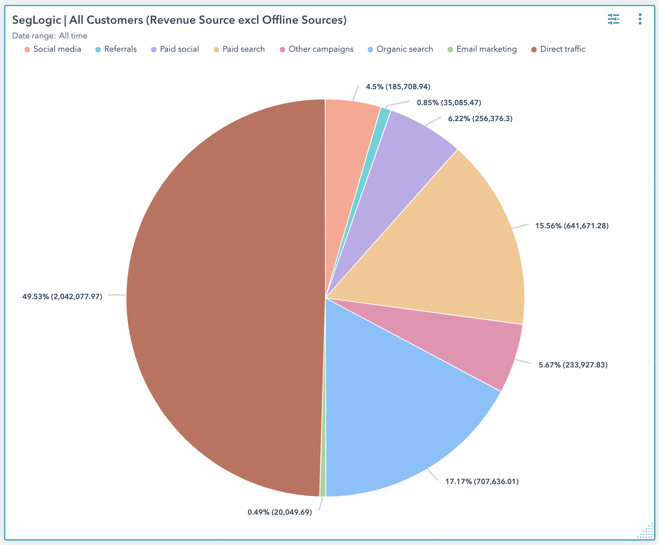
In the above example store, Paid Search & Paid Social comprises 23% of all Original Source sales for known Ecommerce sources.
When including Organic Search sales (17.1%) we're now at 40% of customer acquisition sources.
(ps, I cover HubSpot chart building like above in this article)
I've previously written on big-picture New Customer ad retargeting, but this post is a more specific strategy guide is how you can experiment with campaigns like this for higher-value New Customers so that you're putting less ad dollars at risk when trying to increase your repeat purchase rate.
As pointed out in this article and many others, retargeting/remarketing to existing customers is an unfortunately overlooked communication strategy: You have a much higher chance of re-converting an existing customer than you do getting an initial sale from a search or social ad, so with the right economics it makes a lot of sense to re-investing into customer outreach via paid channels.
Since 1st time ecommerce buyers are by no means loyal (aforementioned <50% repeat purchase rates), I'd argue that ecommerce is one of the most important industries for running New Customer retargeting campaigns.
I hope this helps drive the point home because I can't count the amount of times I've seen Facebook or AdWords Audiences of "Existing Customers" being intentionally excluded from ALL active retargeting campaigns.
(Note that I'm assuming you've already implemented the free components of a New Customer Welcoming campaign as discussed in this article: please don't try to raise your repeat buyer rate with paid ads before you've implemented at least an email campaign!)
Reducing Risks With High-Value New Customers
Here's two simple targeting criteria for reducing the risk on your retargeting ad spend to new customers, which can be easily set up in HubSpot. Only target customers:
- Who came from the Original Source of Paid Search, Paid Social, or Organic Search
- With a First Order Value above a threshold that's more associated with repeat buyers (explained below)
The more your marketing test group aligns with your ideal profile, the higher your conversion rate will be. This is especially important for paid retargeting campaigns, so we chose these two criteria to minimize risk to ad spend for this experiment.
Criteria #1: Three Original Source Options
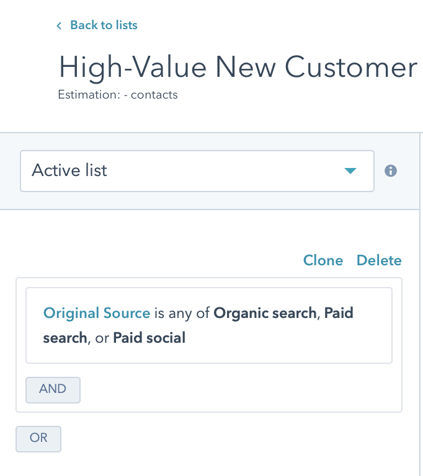 Create a new Active List with the name "High-Value New Customer Retargeting List" or something like that. Per the criteria above, add "Original Source is any of Organic search, Paid search, or Paid social".
Create a new Active List with the name "High-Value New Customer Retargeting List" or something like that. Per the criteria above, add "Original Source is any of Organic search, Paid search, or Paid social".
By contrast, if we were also targeting customers who first came via "Direct Traffic" or "Social media", we don't have any evidence that they interact with paid ads on social networks or search results. (If you've got a large enough database, you could also leave "Organic search" out of this criteria in order to only focus on customers who you KNOW are responsive to paid advertising efforts)
By communicating with these customers on the same social and search platforms where they found you in the first place, you're giving yourself a better opportunity of staying "top of mind" while browsing on these platforms.
Criteria #2: First Order Value Threshold
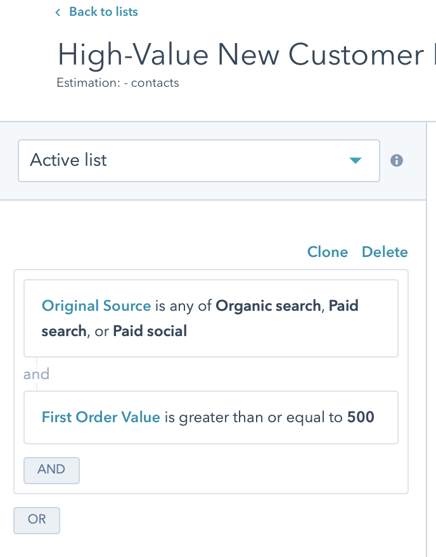 Add onto that Active List you've started by putting in the Unific First Order Value property. Click "AND" and then add "First Order Value is greater or equal to 500".
Add onto that Active List you've started by putting in the Unific First Order Value property. Click "AND" and then add "First Order Value is greater or equal to 500".
The 500 number there is incidental for the time being.
Over the dozens of customer databases I've analyzed I've consistently seen that customers who go on to have a high Customer Lifetime Value (CLV) with a brand tend to place a larger 1st purchase than customers who only ever end up buying once.

In the screenshot above, all customers are sorted with the highest CLV customers at the top, which allows the top 1% of customers (only 45 people in this case) to account for a whopping 19.67% of the company's lifetime sales. The top 20% of customers accounts for 63.95% of sales.
The "# of Orders", "1st Order Value", and "Lifetime Value" column shows the median ("halfway average") of the customers in each of those rows.
In the bottom row we can see that accounting for "Everyone" - all 100% of customers and sales - customers will typically buy 1 time and their "First Order Value" is $705.90. This bottom row adds in the remaining 80% of customers in the business, but those 80% of lowest value customers only contribute 36.05% of the store's lifetime sales.
These are very, very common numbers to see. This is why the 1-time buyer base can be so detrimental to your business if you aren't acquiring enough new customers who will go on to become high-quality repeat buyers.
Look at the "1st Order Value" and "Lifetime Value" differences between the Top 20% row and the bottom row:
- Top 20% of buyers have a typical CLV of $3,945.86, spending $2,112.50 on their 1st order
- Everyone in the list have a typical CLV of $967.68, spending $705.90 on their 1st order
This is a MASSIVE difference in 1st order spend, and I see this over and over when doing analysis across business types and industries.
There's a lot of possible reasons I've discussed with clients that explain why better customers make a larger 1st purchases:
- Better quality customers have done more research before their 1st purchase and feel more comfortable making a larger purchase
- Better quality customers can be less price-sensitive and will buy what they need and want without waiting for discounts
- Better quality customers will need more of the product suite you have to offer - maybe they're a serious hobbyist, another business, or some other persona worth monitoring - and their lifestyle will just cause them to want to commit more money from the onset
Rather than having to wait to see if a New Customer becomes a great customer later, you can know from their very first purchase if they fit the pattern of a higher-value customer and therefore have a higher likelihood of purchasing again.
We offer a paid Customer Journey Analysis that will tell you these numbers for your own business, but you can create a ballpark of this data within a HubSpot Report that will give you enough of a good guess to get started:
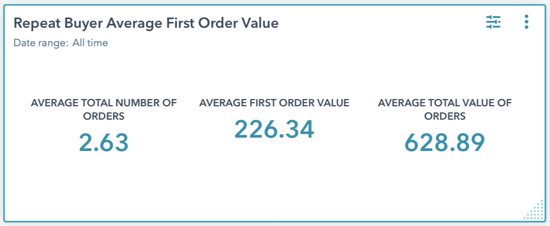
Follow these HubSpot Report steps to get the First Order Value number for this retargeting list:
- Create a "Custom Report"
- Select "Single Object" and "Contacts"
- Name the report "Repeat Buyer Average First Order Value", for example
- Under "Filters" in the top left, change it to "First Order Date" and "is all time"
- Under "Other Filters" add "Total Number of Orders is greater than or equal to 2"
- Under "Selected Properties" add "First Order Value", "Total Number of Orders", and "Total Value of Orders"
- Click the orange "Next" button in the top right to enter the "Visualization" tab
- Under "Choose chart type" select "Summary"
- Drag in "Total Number of Orders" and change it from "Total" to "Average" (shoutout to the feature request adding "Median" to report statistics)
- Likewise, drag in "First Order Value" and change it from "Total" to "Average"
- Finally, likewise, drag in "Total Value of Orders" and change it from "Total" to Average"
- Click the orange "Save" button
Whatever number is in there can now be used as the Active List criteria for your retargeting list under "First Order Value is greater than or equal to X".
This is not as detailed or robust as our median-based system-wide Customer Journey Analysis, but it's enough for you to intelligently limit your retargeting ad spend to exclude New Customers who are less likely to buy again.
As a sanity check for yourself, you can also clone this dashboard two times and see it with "Total Number of Orders is equal to 1" and "Total Number of Orders is known" to see how this limit compares to your 1-time buyer and system-wide first purchase values, respectively:
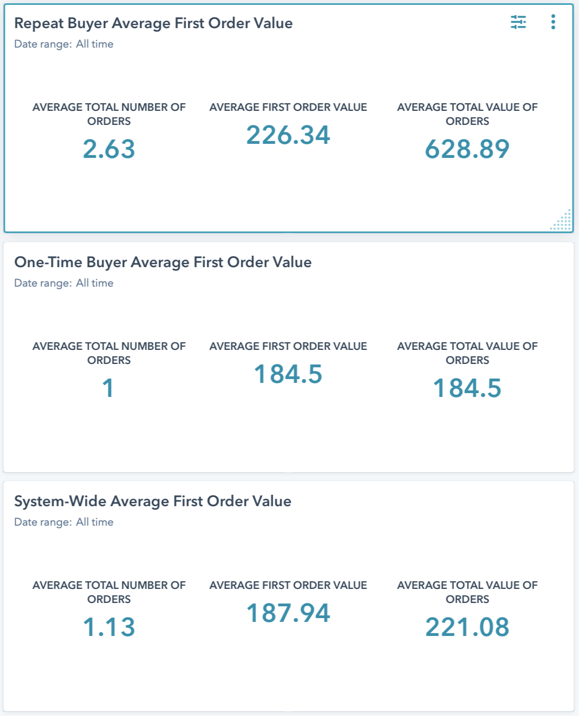
Note per the screenshots on this example client that there IS indeed a big difference between repeat buyers' average first order value and lifetime order value. Buy retargeting customers whose First Order Value is greater than or equal to a rounded $225, you're investing this ad money into staying top-of-mind for customers who are much more likely to repeat buy, and on average will spend 3.4x as much over their lifetime as customers who will only buy once!
Go ahead and add your HubSpot Active List we started and let's talk about the New Customer segment we'll be targeting.
Campaign Timing for Retargeting Ads
As covered in the New Customer Welcoming article, there's a few high-level content strategies you can implement for retargeting ads:
- Advertising Community-Building or How-To Content About Your Products: This is where promoting articles your customers have liked that help them get the most out of your product could be valuable. If you have a private community Facebook group, you could run ads to these customers about the benefits of engaging in that community
- Sending 2nd Purchase Ideas Around When They Should Buy Again: This requires an understanding of your typical repeat purchase times, but maybe at the 45-60 day mark after their purchase you could start sending ads that offer a carousel of popular next purchase products
- Customer Starts to Become Unresponsive to Marketing Emails: If a customer is no longer engaging in your marketing emails, there's a good chance that some "We miss you" messaging would still be effective on social
In line with the last New Customer Winback article I wrote, I'm going to target the "Churn Risk" new customers who are at risk of never buying again. For this group you can use a combination of Strategy 3 ("We miss you" messaging) along with Strategy 2 (a carousel of popular next purchase products).
If you've implemented our New Customer Journey Segmentation article, this will be as easy as adding the proper "Customer Segment" field value as an "AND" criteria in the list to "contains any of New Customer | 3. Churn Risk", like this:
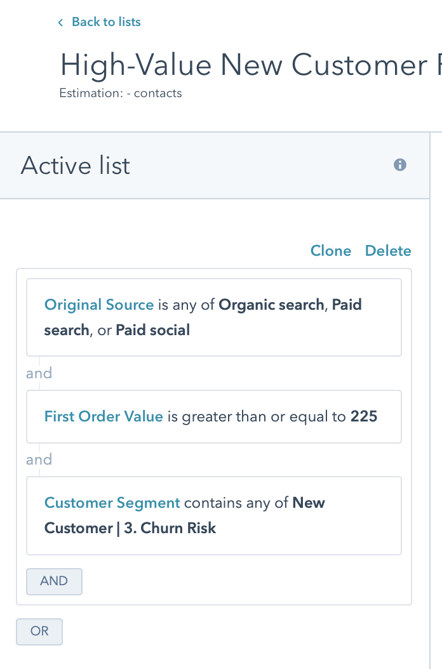
If you have NOT set up that "Customer Segment" property, then you can input the raw criteria as explained in this New Customer Winback article, combining a Last Order Date range with Total Number of Orders is 1:
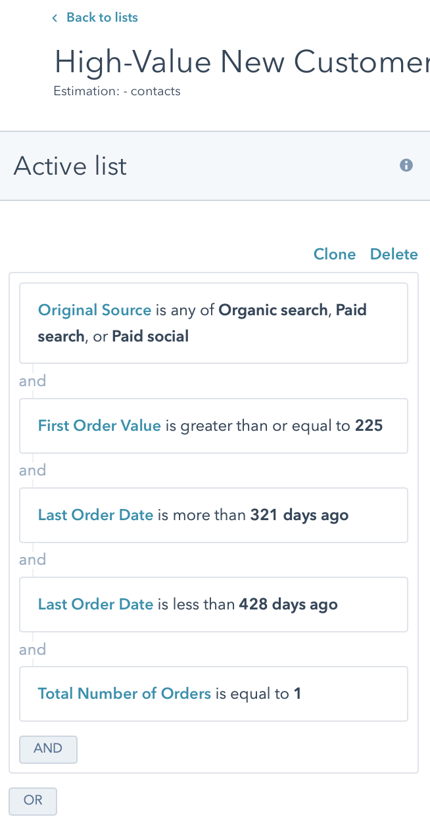
Note that when a customer has only bought one time, both "First Order Date" and "Last Order Date" will be the same, but I just use "Last Order Date" in ALL Winback campaigns for the sake of consistency.
Now you're done and you can follow this HubSpot guide to push this list as a custom audience into one or both of your ads tools.
A few notes from that article of the Active List size requirements for sending to the platforms:
- Google Ads audiences should meet the following size requirements:
- Google Search Network: at least 1,000 active visitors or users within the last 30 days.
- Google Display Network: at least 100 active visitors or users within the last 30 days.
- YouTube: at least 1,000 active visitors or users within the last 30 days.
- Gmail: at least 100 active visitors or users within the last 30 days in the Display Network.
- Facebook Ads audiences must contain at least 20 users.
- LinkedIn Ads audiences must contain at least 300 members.
I'm not going to cover the content strategy here (there's plenty of great Facebook and Adwords specific content strategy guides that are easily Googlable), but I'm just going to cover setting up the HubSpot list to push into your ad platforms.
At least 50% of ecommerce new customers will never buy again and it's also 10x easier to convert an existing customer than convert a new one. Using those axioms and the advice from this article, you can use retargeting ads to new customers to push up your repeat purchase rate. Even a 1-2% increase can make a huge impact on your business over time!
Get a Free Customer Journey Analysis!
Identify actionable differences in your Ecommerce customer behavior to focus your marketing efforts. Our subscription eliminates many workflow and report building steps from this article.

